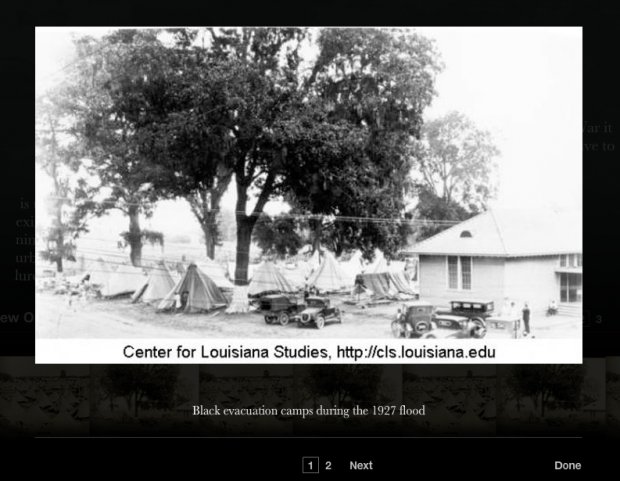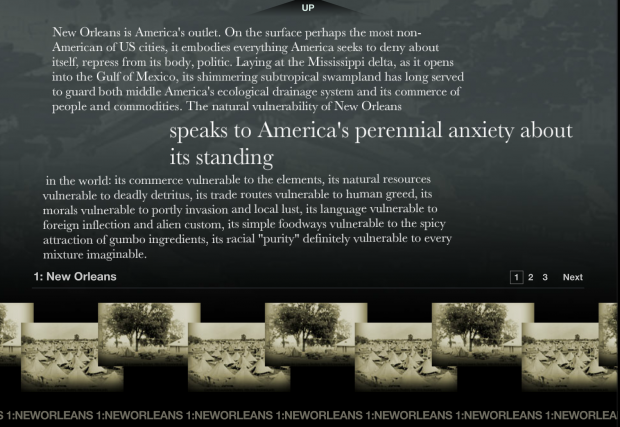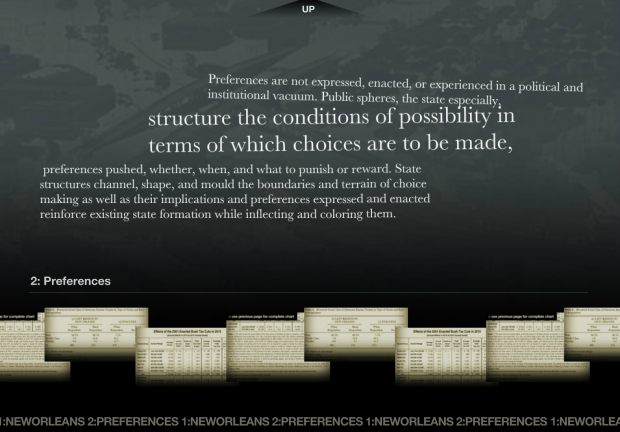Blue Velvet
Blue Velvet is a documentary about Hurricane Katrina and its affect upon New Orleans, LA. “Combining sound, text, photography, video, and several maps, the piece sculpts an evocative and poignant landscape that nonetheless refuses all registers of nostalgia, insisting as it does that we locate Katrina and the Crescent City among multiple trajectories of policy, memory, and representation”
(Source: “Blue Velvet”—Vectors, cited in the Electronic Literature Exhibition catalogue).
Blue Velvet: Re-Dressing New Orleans in Katrina's Wake" is an interactive essay enabling its users to submerge themselves in a poetic wordscape describing the contours of American racial politics post-Katrina.
Artists' Statement
Scholars in the Humanities have long labored under the conceit of the auteur mode of production. We are taught and reproduce the illusion that we produce our work alone, in isolation, thinking great thoughts pretty much on our own, in conversation if at all with the great works produced for the most part in this way. Composing "Blue Velvet" was a stark reminder of how wrong-headed this picture largely is. The very idea for the piece came out of a conversation with Tara McPherson. It would look nothing like it does now but for the incredible design work of Erik Loyer and cartographic shaping and mediated elaboration enabled by Stefka Hristova. The final product is the outcome of intense weekly conversations over something like a year between the four of us about design, look, content, navigation, media, technological failures and fixes, in short, about New Orleans literally and metaphorically. But there were other inputs, exchanges, relations that helped make the piece come to life, from silent conversations with writers and artists who have felt the pulse of the Big Easy, in moments of health and illness, as well as with theoretical and political critics of neoliberalism. The sooner we get over the conceit of solipsistic self-production, the better off the Humanities will be.
But the process confirmed something more than this. Much of writing in the Humanities has tended to be linear. "Blue Velvet," however, encourages connections, transversals, relationalities; a writing that is more fragmentary without being self-contained, open to play across dimensions, to interactivity between media, to a different kind of complexity. To mixing and mashups, made and remade.
The stress on metaphoricity consequently becomes crucial. There is, as Godard once remarked, a beginning, middle, and end, but never quite in that order. One can begin again and again, and almost anywhere; while ending one's session with the material as one sees fit. So the writing—better, the composing and orchestration because it is never simply writing in such a forum—is in constant play with the reading, whether concretely or as possibility. So the medium loosens the sense of absolute control. It is as if the material writes you, rather than the reverse. The experience has been liberating, as much from the literality of the linear within the narrow constraints of one's own writing as from the tyranny of the narrowly textual more broadly.
But then New Orleans will tend to have that effect on one too.
(Source: 2008 ELO Media Arts show)
Design by Erik Loyer.





